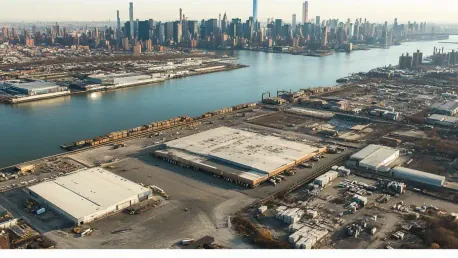The New York City Committee on Environmental Protection, Resiliency, and Waterfronts has initiated oversight hearings to address local laws and city codes concerning the regulation of indirect sources of air pollution stemming from last-mile mega-warehouse operations. These hearings aim to fill the regulatory gaps and mitigate the public and environmental health harms caused by the under-regulated and expanding mega-warehouse traffic and consequent diesel pollution.
The E-commerce Boom and Its Consequences
Rise in Diesel Truck Traffic
The swift growth of e-commerce has significantly increased the number of diesel delivery trucks on the roads, resulting in elevated levels of toxic air pollutants like particulate matter, nitrogen oxides, and volatile organic compounds. These pollutants deteriorate local air quality and heighten the risks of asthma, heart attacks, and premature deaths in nearby communities. As e-commerce giants continue to expand their operations and expedite delivery times, the frequency of delivery trucks on the streets has surged dramatically. This continuous influx of diesel trucks relentlessly circulates through residential neighborhoods, directly impacting the day-to-day lives of residents. Families living near these routes are exposed to a constant barrage of pollutants right outside their doorsteps, contributing to a public health crisis. The environmental imbalance is glaring, and these pollutants have long-term detrimental effects not only on human health but also on the overall ecosystem. Current policies have failed to keep pace with this unprecedented growth, leaving a regulatory void that endangers the well-being of many communities.
Environmental Impact of Mega-Warehouses
The 24/7 operations of these mega-warehouses further amplify their environmental impact, producing greenhouse gas emissions comparable to those from power plants and factories. Despite this, current regulations fail to account for the modern-day use of e-commerce mega-warehouses and their constant diesel truck traffic. These facilities operate at a frenetic pace, insufficiently monitored and regulated, contributing to severe environmental degradation. The diesel truck traffic alone generates staggering amounts of greenhouse gases, posing a significant threat to New York City’s climate goals. Often, the emissions from a single mega-warehouse rival those of smaller industrial plants, further complicating efforts to curtail pollution. In essence, these warehouses create a constant flow of toxic emissions, turning urban and suburban areas into pollution hotspots. Moreover, this unmitigated growth poses secondary environmental threats, such as increased runoff pollution and soil degradation, further exacerbating ecological harm.
Disproportionate Effects on Vulnerable Communities
Environmental Injustice
This increase in e-commerce and its associated pollution disproportionately affects communities of color and low-income populations. In New York City, around 3 million people reside within half a mile of a warehouse, with Black residents being 17% more likely, Hispanic/Latino residents 13% more likely, and low-income residents 19% more likely to live near these facilities compared to the general population. The stark contrast in these statistics underscores the systemic nature of environmental injustice deeply ingrained in urban planning and zoning practices. Black and Hispanic/Latino communities, alongside low-income populations, often find themselves at the epicenter of this pollution crisis. The chronic exposure to hazardous air quality exacerbates existing health disparities, contributing to higher rates of respiratory and cardiovascular diseases in these neighborhoods. This pattern of pollution, driven by the logistics needs of affluent areas, delineates clear boundaries of environmental racism. Addressing these inequities demands systemic change and robust enforcement of environmental protections to safeguard marginalized communities from further harm.
Systemic Issues in Warehouse Siting
The distribution pattern highlights the systemic environmental injustice prevalent in warehouse siting. The conversation also highlights long-standing issues faced by communities of color and low-income neighborhoods due to polluting mega-warehouses and their diesel truck traffic. Historically, regulatory oversight has neglected the environmental footprint of these facilities in favor of economic expediency, perpetuating a cycle of neglect and degradation. Delving deeper reveals a troubling history of zoning decisions that place industrial operations within or near vulnerable communities, driven by lower land costs and fewer political resistances in these areas. This systemic oversight has long subjected these neighborhoods to disproportionate levels of pollution, with little recourse or intervention. The health impacts, coupled with the socioeconomic stressors these communities face, paint a grim picture of entrenched environmental inequality in urban planning. Combating these issues requires a comprehensive and inclusive approach to revamp warehouse siting policies with an emphasis on environmental justice.
Proposed Solutions and Legislative Measures
Indirect Source Review Policies
To tackle the pollution from these warehouses, innovative Indirect Source Review (ISR) policies are being considered. Council Member Alexa Avilés has proposed legislation requiring the Department of Environmental Protection (DEP) to identify heavy-use thoroughfares in each borough and to install street-level air monitors at key intersections and adjacent to parks or playgrounds along these routes. These measures aim to meticulously track and document pollution data, laying the foundation for informed regulatory actions. Implementing ISR policies represents a proactive step towards curbing the environmental impact of these facilities. Detailed air quality monitoring will enable more accurate identification of pollution hotspots and the deployment of targeted interventions. Moreover, it provides a clear framework for accountability, compelling e-commerce giants to acknowledge and address their environmental footprints. Such initiatives not only curb pollution but also foster public awareness and community involvement in environmental protection efforts. Over time, these policies could significantly mitigate the harmful effects of diesel pollution in both densely populated areas and vulnerable neighborhoods, promoting healthier living conditions across the city.
Support from Key Figures
Several key figures have voiced support for the proposed regulations. Council Member Alexa Avilés emphasizes the need for this legislation to improve air quality and bring relief to communities burdened by unregulated distribution operations. Brooklyn Borough President Antonio Reynoso calls for balancing the demand for e-commerce convenience with the need for clean air and safe streets, particularly in marginalized communities. The broad spectrum of support indicates a unified acknowledgment of the issue and the urgency for intervention. Assembly Member Claire Valdez, representing the district with the highest concentration of these facilities, advocates for stronger regulations to protect public health, worker safety, and the environment. The empathy and resolve exhibited by these representatives underline a commitment to fostering equitable and sustainable urban planning. Furthermore, the collective advocacy by community leaders and politicians illuminates the potential for policy changes to bring about substantial improvements in air quality and public health. The legislative push also signals a shift towards integrating environmental justice into mainstream policy discussions, a critical pivot for addressing systemic inequities.
Community and Advocacy Group Support
Local Community Boards and Advocacy Groups
Local community boards and advocacy groups also back the legislation. Katie Walsh from Brooklyn Community Board 7 highlights the disproportionate burden placed on areas like Sunset Park and Red Hook due to last-mile trucking facilities. Jaqi Cohen from the Tri-State Transportation Campaign underscores the need to hold e-commerce companies accountable for the pollution they generate. These local voices play a crucial role in drawing attention to the nuanced impacts of mega-warehouse operations on day-to-day life in affected communities. The coalition of grassroots organizations brings invaluable insights and perspectives, ensuring that policies are not only comprehensive but also community-centric. Their advocacy underscores the importance of involving residents in the decision-making process, especially those directly impacted by pollution. By amplifying the lived experiences of affected communities, these groups spotlight the urgent necessity for reforms that prioritize human health over industrial convenience. Engaging with local boards and groups fosters a collaborative approach to problem-solving, ensuring that legislative measures are reflective of and responsive to community needs.
Health Impacts and Calls for Action
Jessica Enzmann of the Sierra Club, Kevin Garcia from the New York City Environmental Justice Alliance, and Dariella Rodriguez from THE POINT CDC each point to the severe health impacts on communities located near these mega-warehouses. They call for measures to reduce truck traffic and improve air quality to protect community well-being. Their advocacy highlights the direct correlation between industrial activities and public health crises, emphasizing the need for immediate and sustained action. By aligning their efforts, these advocacy groups elevate the discourse around environmental justice and public health, bringing scientific data and community testimonies to the forefront. The collective voice of these organizations calls for substantive, rather than token, regulatory changes. Strategies proposed include optimizing delivery routes to minimize truck traffic through residential areas, enhancing emissions standards, and investing in greener technologies. Such multi-faceted approaches address the issue holistically, recognizing that reducing pollution necessitates coordinated efforts spanning policy, technology, and community engagement. These calls for action reflect a shared vision for healthier, more resilient neighborhoods free from the burdens of industrial pollution.
Future Steps and the Path Forward
Regulatory Oversight and Environmental Impact Mitigation
Willis Elkins from the Newtown Creek Alliance and Elizabeth Yeampierre from UPROSE stress the need for regulatory oversight to mitigate the environmental impacts of shipping facilities and reduce the disproportionate air pollution burden on vulnerable neighborhoods. Instituting stringent regulatory oversight ensures that the environmental costs of expansion are not borne exclusively by marginalized communities. Their perspectives emphasize that effective oversight requires robust data collection, transparent reporting, and enforceable standards. Regulatory frameworks must include stringent penalties for non-compliance, compelling businesses to adhere to environmental best practices. By holding operations accountable, these measures aim to shift the industry towards more sustainable practices. Additionally, ongoing community engagement and feedback mechanisms are vital to monitor the effectiveness of implemented policies and adjust them as necessary. This dynamic and responsive approach to regulatory oversight ensures that environmental protection evolves in tandem with industry practices, fostering long-term sustainability.
Transition to Clean Transportation
The New York City Committee on Environmental Protection, Resiliency, and Waterfronts has begun holding oversight hearings to investigate local laws and city codes related to the regulation of indirect sources of air pollution caused by last-mile mega-warehouse operations. The rapid expansion of these massive warehouses has led to a significant increase in traffic, especially by diesel-powered vehicles, which results in increased air pollution. The committee’s goal is to identify and address the regulatory gaps that currently exist. By initiating these hearings, the committee hopes to develop stricter regulations and policy changes that will reduce the public health risks and environmental damage associated with these under-regulated mega-warehouse operations. The hearings represent an essential step in ensuring that the city can mitigate the negative impacts of growing warehouse-related traffic and diesel emissions, which pose serious health and environmental challenges. In summary, the NYC Committee is actively seeking solutions to the significant pollution and health problems caused by the increase in traffic from last-mile mega warehouses. By closing regulatory loopholes and strengthening existing laws, the city aims to protect both public health and the environment from the adverse effects of such operations.









